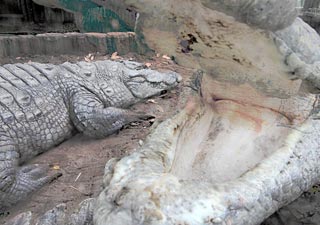
Copyright © Jim Austin
See over there? It’s feeding time for the alligators – it must be noon, on a Sunday. Sixty gators are looking at their trainer, a staff member at St. Augustine’s Alligator Farm (SAAF). These gators are ready for a taste of nutria, a rodent raised for alligator chow. Lenses focus as a unique drama unfolds. It’s time for Croc School.
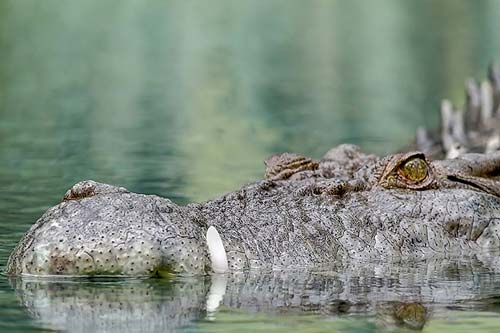
Copyright © Jim Austin
A Salt water crocodile, Maximo’s distinguishing feature is a four – inch -long tooth that juts upwards from his lower jaw.
one morning, on an offshore trip
Croc School
Croc school is an exciting change at this St. Augustine zoo. About 750 alligators and crocodiles live at the SAAF, with some of these in training. During feeding, trainers teach the gators both by verbal commands and by gestural cues. The reptiles learn to keep their distance. Ten of them have even learned their names.
Recently, Staff from other US zoos traveled to the SAAF for Croc School. While at first they were skeptical, these animal pros learned that alligators can be trained. After a week at the SAAF on St. Augustine’s AnastasiaIsland, the zoo staff returned home to teach new training routines to alligators in their local zoos.
Gator Research
Back at the Alligator Farm, I talked to director John Brueggen. He said he once played a recording of a young alligator in distress, over a speaker, to a group of gators in the main pond. All of the alligators oriented to the source of the sound, and some searched for the “distressed” youngster so vigorously they collided with the speaker.
Mr. Brueggen also noted that alligators, a 65 million year old species, seem to have a sense of time. When fed only once a week, Sunday at noon, the SAAF gators lined up near where they were fed, just before feeding time, starting about 11:45 am.
Maximo (pictured above)
Exploring the Alligator Farm, everyone eventually comes face to face with Maximo. Just follow the drum music. You’ll discover a large pool behind a clear glass wall. It is home to a salt water crocodile, the largest reptile on Earth.
Unlike his overweight predecessor Gomek (a crocodile who weighed over a ton at the time of his death), Maximo is required to exercise with each feeding. His trainers make Maximo come up out of the water to receive his food. This is a part of a well-rounded program to keep Maximo fit.
Another long term SAAF project was for an endangered species of alligator.
Chinese Alligators
According to Director John Brueggen, when the habitat of the Chinese Alligator was threatened, it was impossible to get an accurate head count of the number of Chinese alligators left. No one could determine their status. Farmers would report to city government officials that they had seen one or two gators in their fields, but no one really knew how many still existed. After some negotiation, a few alligators were sent from China to the Alligator Farm. There, a consistent diet and managed breeding led to a successful outcome.
Now, nine Chinese alligators from the US, including 3 raised at the SAAF, are back where they belong in China. This group is thriving on Chongmng Island in Shanghai. Their progress is monitored by a graduate student.
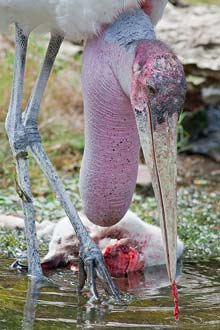
Copyright © Jim Austin
A Marabou Stork bathes after a meal.
Not Just for Gators Anymore
Although this world renowned zoological garden has 26 alligator species, over 100 other species also make their home at the Alligator Farm.
This variety ensures you’ll see exciting changes in the birds, monkeys, tortoises and other exhibits with each visit. Here is an update on a few of the species. Lets start with an odd-looking stork.
Marabou Storks
These storks have a distinctive pink air sac, which they expand to attract a mate.
Among other skills, this male stork pictured here has learned to keep his distance and not crowd his trainer during feedings. He has also learned to bite a stick held by his trainer so he does not peck at the zoo staff.
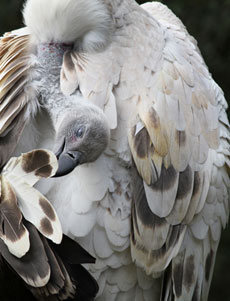
Copyright © Jim Austin
Preening is a precise task for this Cape Griffon Vulture.
Cape Griffon Vultures
There are two breeding pairs of CapeGriffon vultures at the Alligator Farm. One pair is nesting on a stable, shaded platform.
In the past, the platforms built by the captive birds have not been flat enough, and instability caused the birds eggs to roll out of the nest. Since wild vultures live along the sides of high cliffs, their nests have to be level, and built carefully near level patches of ground where they can land and take off. The birds and staff at the SAAF have overcome this challenge, and the vultures are now laying eggs again with success in a stable nest close to the ground.
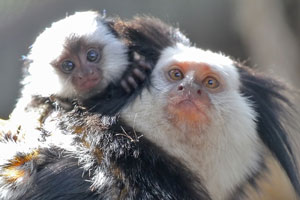
Copyright © Jim Austin
A baby marmoset has a grip reflex that helps it cling to its parents.
Geoffrey’s Marmosets
Marmosets often give birth to twins, and a pair was born recently to Pia, their silky, furred mother. All are thriving in their exhibit, side by side with several Golden Tamarins.
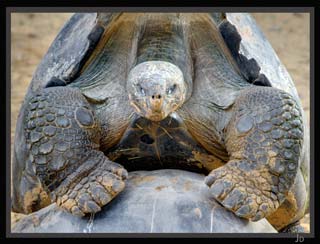
Copyright © Jim Austin
Galapagos Tortoise
Rare species are also represented at the SAAF, such as the Galapagos tortoise, the largest tortoise in the world. It’s easy to photograph these herbivorous land turtles as they never seem to be in any hurry.
t the puffins also
A Final Chorus
Not far from the tortoises, the walkway above the north gator pond has been completely renovated and enlarged. As you leave the Alligator Farm, walking along this wooden boardwalk, you may hear a chorus of bellowing male and female alligators. They are letting their family know their location, gender, and size. Perhaps this bellowing is a type of alligator GPS.
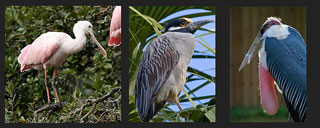
Copyright © Jim Austin
Left: Roseate Spoonbill
Center: Black Crowned Night Heron
Right: Marabou Stork
Turn on your own GPS and find your way to the St. Augustine Alligator Farm or visit their web site.
ind perfect moments fishing in the open sea
by Jim Austin, M.A., A.C.E.

Leave a Reply